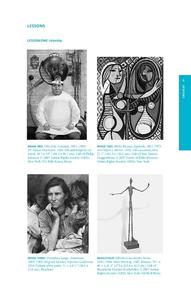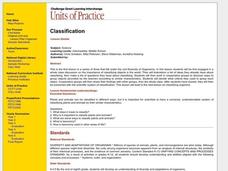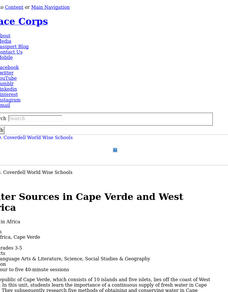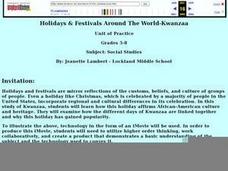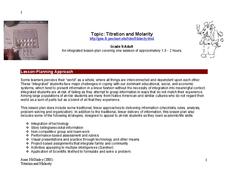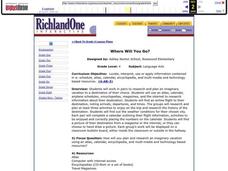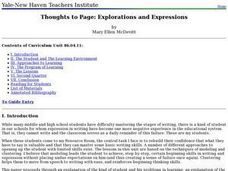Curated OER
Critical Reading: Intelligence Augmentation
In this critical reading instructional activity, students read a short passage regarding intelligence augmentation and then answer five questions based on the reading.
Curated OER
Permafrost
Students use a thermometer to analyze soil temperature data to determine which soil sample is normal, and which one is permafrost. In this permafrost lesson plan, students participate in a hands on activity where they identify the active...
Curated OER
Conjectures and Conclusions
Students draw conclusions and make conjectures given a specific scenario. In this geometry lesson, students model real life scenarios using properties of triangles. They model number facts and explain why the outcome is what it is.
Curated OER
The Time of Man
Students demonstrate visually Mankind's relative place on the earth's timeline. They familiarize themselves with the use of the metric system in measuring and producting a timeline.
Curated OER
Juvenile Justice-Disposition
Students explore the dispositional hearing as a part of the juvenile justice system. After a brief discussion of the parts of the disposition hearing, students work in groups to review case studies involving juveniles in Utah's justice...
Curated OER
Identity
Students analyze identify in art. In this art analysis lesson, students discuss what identify means and discuss how Otto Dix, Pablo Picasso, Dorothea Lange, and Alberto Giacometti represent identities in portraiture. Students complete...
Curated OER
Classification
Students investigate how to classify items based on similar characteristics. They study the scientific system of classification.
Curated OER
Water Sources in Cape Verde and West Africa
Learners analyze the importance of a fresh water supply in Cape Verde, researching five methods of obtaining and conserving water there. Young scholars create and present displays demonstrating their understanding of the methods of water...
Curated OER
Holidays & Festivals Around The World-Kwanzaa
Students use technology to conduct research. They use technology to convey principles and information. They demonstrate proficiency in the use of computer based technology.
Curated OER
Red, Green, and Blue Mystery Liquids! Hypothesis or Inference?
Eighth graders are actively involved in the scientific method and inquiry as they form quick hypotheses based upon a teacher set of mystery liquids. They determine the need to make additional observations of the liquids.
Curated OER
When Rice Was King
Young scholars examine the origins of rice production in the South. They identify the steps involved in rice cultivation, examine photos of plantation life, conduct interviews, and research the economic base of their own community.
Curated OER
Web Page Creation
Students complete a unit of lessons on web pages and web page creation. They conduct Internet research, identify the characteristics of effective and ineffective websites, construct a glossary of terms, and develop three web pages.
Curated OER
Time Management
Students are taken through the design process to develop a system of time management for themselves and others. They practice participating in a critique of other students' time schedules and modify and improve their initial time...
Curated OER
What is Climate?
Learners explore the differences between climate and weather. For this introductory lesson of a climate unit, students discuss the vocabulary and concepts associated with weather and climate. They build their information base for the...
Curated OER
Titration and Molarity
Students investigate the concept of molarity and its relationship to the concentration of a solution. After mixing chemical solutions, they calculate how many moles of acid and base should be in each solution. They record their results...
Curated OER
America 2000: Federal Round Table Discussion
Eighth graders examine the United States Constitution and identify the beliefs and values Americans follow today. In groups, they compare and contrast state's rights and federal rights and the issues affecting them. They debate the...
Curated OER
Exploring the Properties of Rectangular Prisms.
Students define properties of rectangular prisms. In this geometry instructional activity, students identify the relationship between two and three dimensional objects. They use Cabri technology to graph their figures.
Curated OER
Exploring Properties of Rectangular Prisms
Learners explore the properties of rectangular prisms. In this geometry instructional activity, students identify properties of two and three dimensional shapes. They use Cabri technology to create polygons and solve problems.
Curated OER
Measuring Elapsed Time
Fifth graders convert units within the same measurement system and be able to determine elapsed time. They are given a start time and an end time of a game. Students determine the amount of elapsed time from the data that is given.
Curated OER
Where Will You Go?
Fifth graders research and plan an imaginary vacation. In this travel planning lesson, 5th graders work in pairs to use an atlas, calendar, review airplane schedules, encyclopedias, magazines, and the Internet to research information...
Helping with Math
Identifying and Writing Decimals up to Thousandths
A simple worksheet asks learners to write five numbers in decimal form. Sets of blocks represent the numbers and include whole number blocks, tenths, hundredths, and thousandths. Use this to follow other worksheets by the same publisher...
Curated OER
New York State Testing Program: Mathematics Book 1, Grade 4 2007
In this 4th grade math standardized test practice worksheet, students solve 30 multiple choice math problems based on New York academic standards.
Curated OER
New York State Testing Program: Mathematics Book 1, Grade 4 2010
In this 4th grade math standardized test practice worksheet, students solve 30 multiple choice math problems based on New York academic standards.
Curated OER
Thoughts to Page: Explorations and Expressions
Students are introduced to the correct techniques to use for proper writing. In groups, they practice the use of clustering to help them organize their thoughts and identify the main idea of their paper. To end the lesson, they write...







